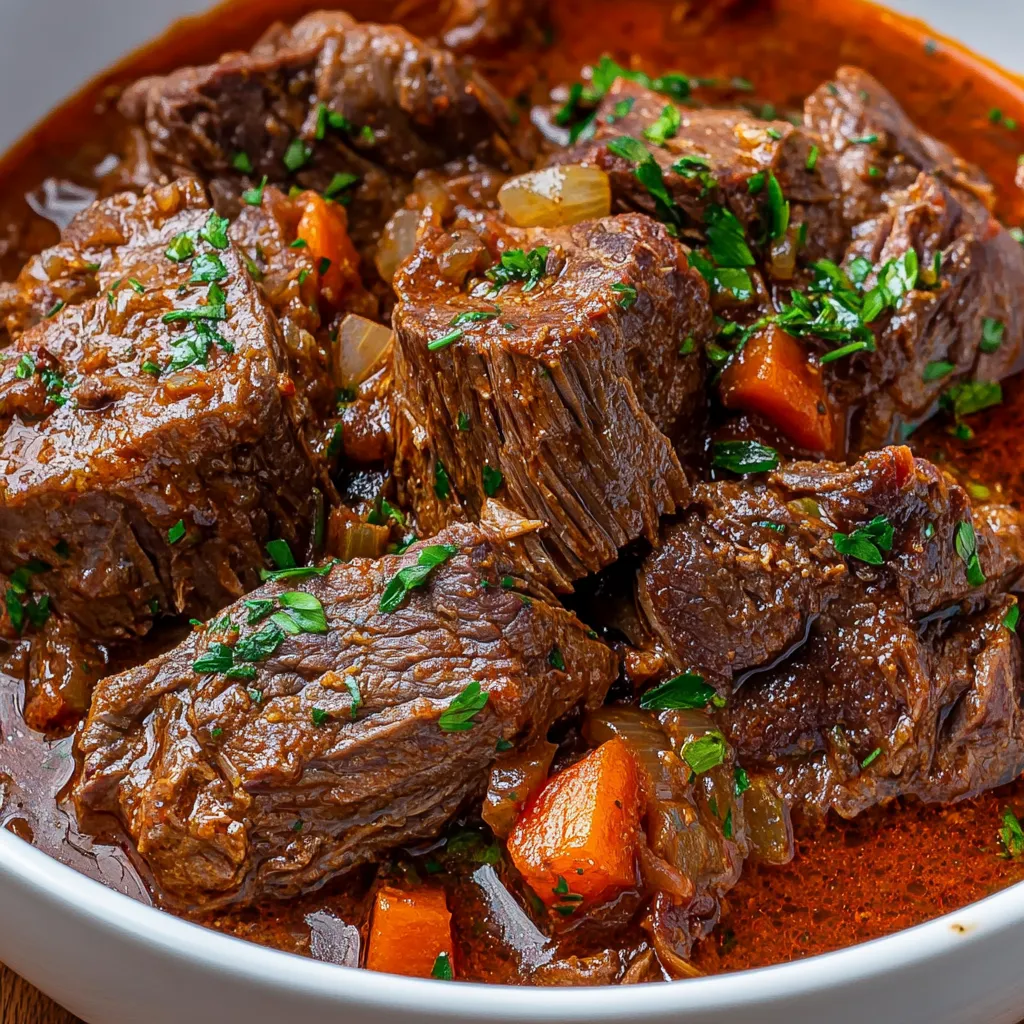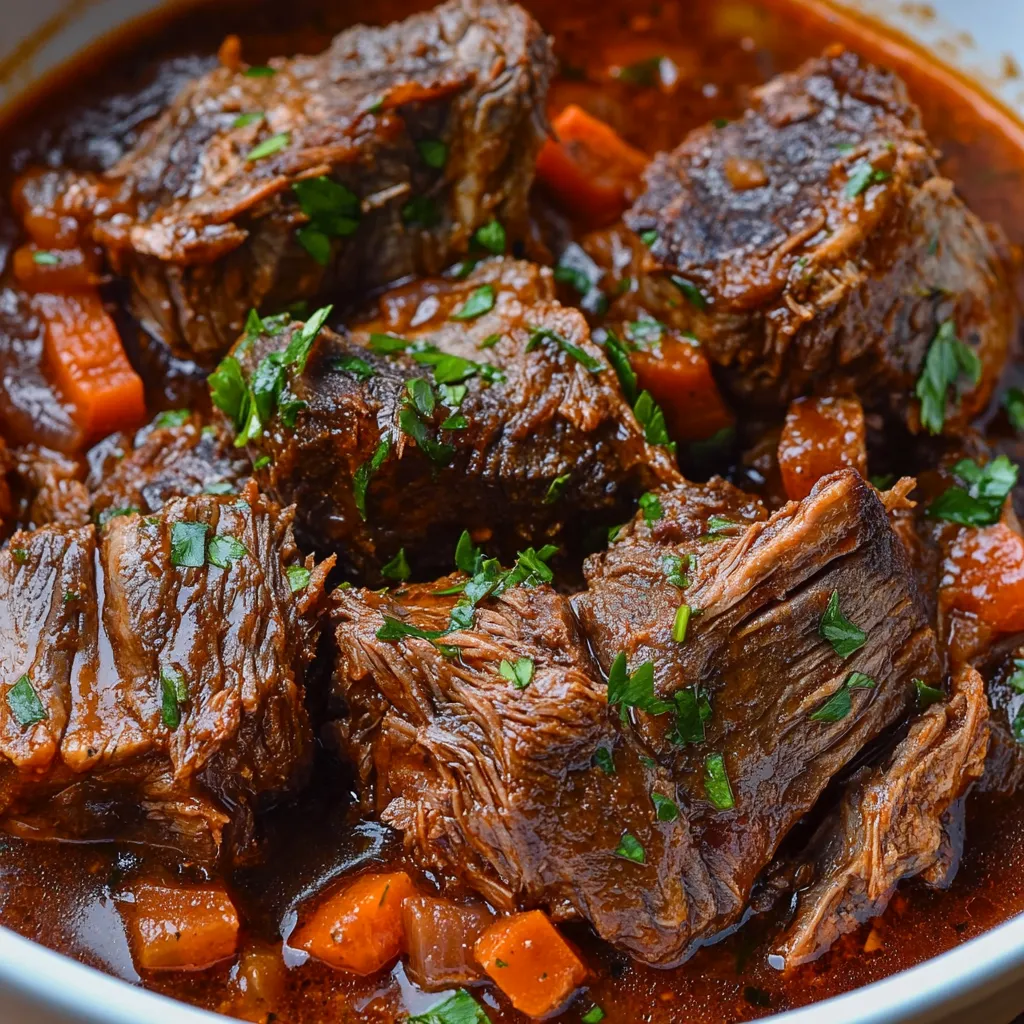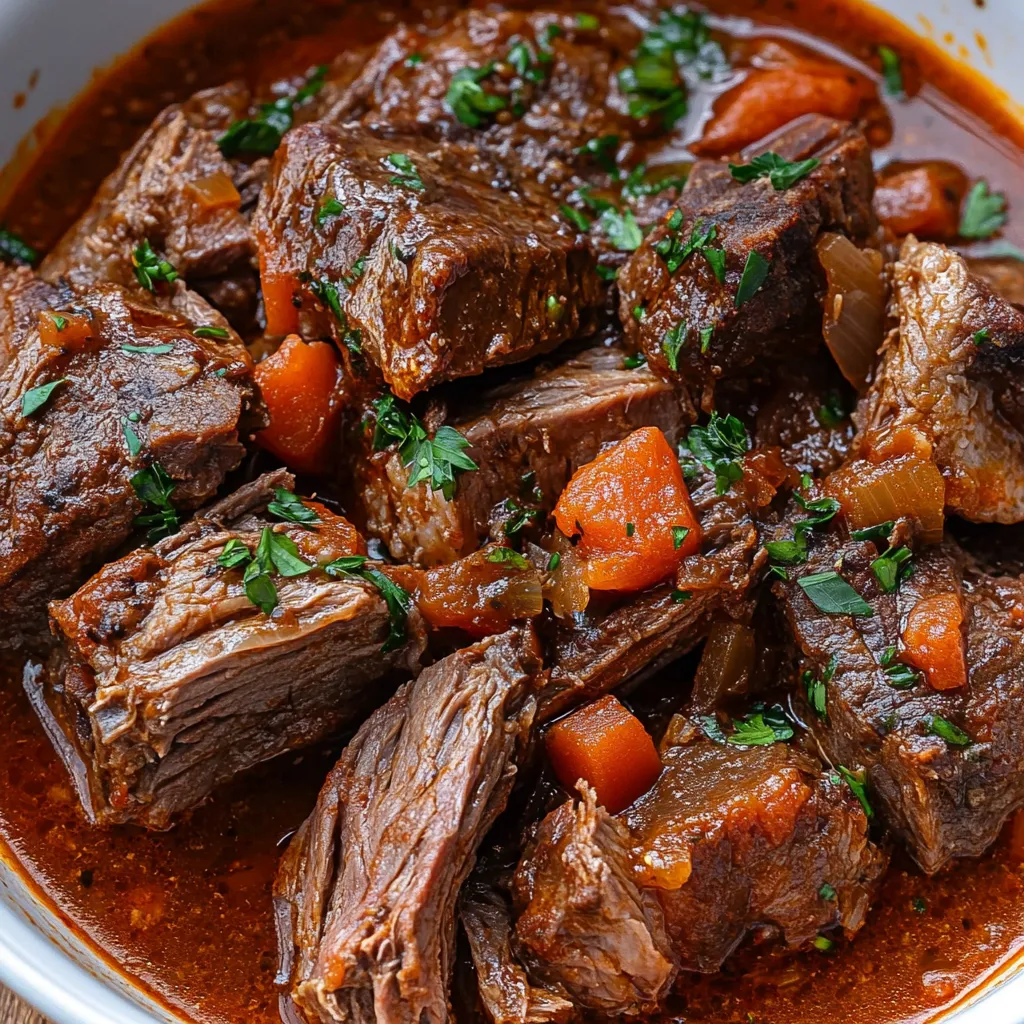 Pin it
Pin it
Italian pot roast, known traditionally as "stracotto," transforms an affordable cut of beef into something truly extraordinary through the magic of slow cooking. This rustic dish combines tender, falling-apart beef with a rich tomato sauce infused with aromatic vegetables and herbs. Unlike traditional American pot roast, the Italian version incorporates the bright acidity of tomatoes and a more complex herb profile, creating a sauce so delicious you'll want to soak up every last drop with crusty bread or polenta.
I first attempted this recipe after visiting a small trattoria in Tuscany where I had the most memorable pot roast of my life. The owner explained that stracotto literally means "overcooked," but in the most flattering way possible. My first home version wasn't quite right—the sauce was too thin and the meat not tender enough. After several attempts and extending the cooking time significantly, I finally recreated that silky sauce and fork-tender meat that made me fall in love with the dish. Now it's my go-to Sunday dinner when family gathers around our table.
Ingredients
- Chuck roast: This marbled cut becomes incredibly tender when braised slowly; look for a well-marbled piece with some fat running through it for the most flavor
- Bacon or pancetta: Provides a foundation of smoky, rich flavor; pancetta offers a more authentic Italian touch, but thick-cut bacon works beautifully too
- Onion, carrot, and celery: This classic Italian "soffritto" creates the aromatic base for the sauce; dice vegetables to a uniform size for even cooking
- Garlic: Fresh cloves add essential aromatic depth; mince them finely to release maximum flavor
- Crushed tomatoes: San Marzano variety offers the best flavor with perfect balance of sweetness and acidity; their thick texture helps create a luscious sauce
- Beef broth: Adds richness and umami; homemade is ideal, but a good quality store-bought low-sodium version works well
- Fresh herbs: Rosemary and thyme infuse the dish with aromatic essence; fresh herbs provide brighter flavor, but dried work in a pinch
- Italian seasoning: This herb blend typically includes oregano, basil and marjoram, adding authentic Italian flavor notes
- Red pepper flakes: Provides a gentle background heat that balances the richness; adjust according to your spice preference
Instructions
- Render the bacon fat properly:
- Begin by cooking diced bacon or pancetta in a heavy Dutch oven over medium heat, stirring occasionally until the fat renders and the meat becomes crispy. This process takes about 5-7 minutes and should be done patiently to extract maximum flavor without burning. Remove the crispy bits with a slotted spoon, leaving the flavorful fat behind as the foundation for your dish.
- Prepare and sear the beef thoroughly:
- Pat the beef pieces completely dry with paper towels before seasoning generously with salt and pepper on all sides. This crucial step ensures proper browning. Heat the bacon fat until shimmering, then carefully place the beef pieces in, allowing each side to develop a deep, caramelized crust before turning. Resist the urge to move the meat too frequently – about 4-6 minutes per side creates the rich flavor compounds that will infuse the entire dish.
- Create the aromatic foundation:
- After removing the seared beef, lower the heat to medium and add your diced onion, carrot, and celery to the same pot. The vegetables will release moisture that helps deglaze the bottom of the pan, incorporating all those flavorful browned bits from the meat. Cook until the vegetables soften and the onions become translucent, stirring occasionally for about 7-10 minutes. This mixture creates the flavor base that will permeate the entire dish.
- Develop the flavor profile:
- Add minced garlic and red pepper flakes, stirring constantly for about one minute until fragrant but not browned. Garlic burns easily and becomes bitter, so watch it carefully at this stage. The brief cooking releases the aromatic oils without risking bitterness.
- Build the braising liquid:
- Pour in beef broth, using it to scrape up any remaining browned bits from the bottom of the pot. Add crushed tomatoes, herbs, bay leaves, and the reserved bacon. This combination creates a complex braising liquid with layers of flavor – umami from the broth, acidity from the tomatoes, and aromatic notes from the herbs. Stir thoroughly to combine all ingredients.
- Braise with patience:
- Return the seared beef to the pot, nestling it into the liquid. The meat should be partially submerged but not completely covered. Choose your cooking method based on convenience – stovetop, oven, or slow cooker – but remember that the magic happens in the low, slow cooking. The collagen in the tough chuck roast needs time to break down into gelatin, which creates that desired fork-tender texture.
- Test for doneness properly:
- Rather than relying solely on time, check for doneness by inserting a fork into the thickest part of the meat. When perfectly cooked, the fork should slide in with almost no resistance, and the meat should easily shred when pulled. This typically takes 3-4 hours in a 275°F oven, but may vary depending on your specific cut of meat.
- Finish and serve thoughtfully:
- Once tender, remove the bay leaves and adjust seasoning with salt and pepper as needed. For the most developed flavor, let the pot roast rest for 15-20 minutes before serving. This allows the meat fibers to relax and reabsorb juices, resulting in more tender, flavorful bites.
 Pin it
Pin it
My grandmother always insisted on making her stracotto a day ahead, claiming it needed time to "rest and dream" overnight in the refrigerator. I thought this was just one of her cooking superstitions until I tried it myself. The flavors truly do deepen and meld after resting overnight. Now I often make mine a day ahead too, especially when entertaining. The added benefit is that you can easily remove solidified fat from the top before reheating.
Serving Suggestions
The beauty of Italian pot roast lies in its versatility. The traditional way to serve it is over creamy polenta, which provides the perfect canvas for soaking up the rich sauce. The contrast between the smooth polenta and the tender chunks of beef creates a textural experience that's absolutely divine.
For a more rustic approach, pair it with roasted potatoes seasoned with rosemary and garlic. The crispy exterior of the potatoes offers a wonderful contrast to the tender meat. During colder months, I love serving it alongside a simple risotto – the creaminess complements the robust sauce perfectly.
Don't forget the importance of a good crusty Italian bread on the side. There's something deeply satisfying about using a piece of bread to soak up the last bits of sauce on your plate – Italians call this "fare la scarpetta" (making the little shoe), and it's considered a compliment to the cook.
Variations Worth Trying
While this classic recipe is perfect as is, I've developed some variations over the years that offer delicious alternatives. For a Tuscan twist, add a handful of pitted Kalamata olives and a tablespoon of capers during the last hour of cooking. These briny additions complement the rich sauce beautifully.
For special occasions, I sometimes add dried porcini mushrooms that have been rehydrated in hot water. The soaking liquid gets added to the braising liquid, and the chopped mushrooms join the vegetables. This creates an even more complex umami flavor that mushroom lovers adore.
During winter holidays, I often incorporate a touch of warmth by adding two strips of orange zest and a cinnamon stick to the braising liquid. These subtle additions create a festive twist that pairs wonderfully with the season without overpowering the dish.
 Pin it
Pin it
Conclusion
I've been perfecting this recipe for over fifteen years now, ever since that transformative meal in Tuscany. What makes this dish special isn't fancy techniques or rare ingredients, but rather patience and respect for tradition. There's something profoundly satisfying about the process – the slow building of flavors, the gradual transformation of a humble cut of meat into something extraordinary. When my kitchen fills with the rich aroma of this simmering pot roast, it never fails to draw my family together in anticipation of the meal to come. That, perhaps, is the greatest joy of cooking – creating moments of connection around something made with care and love.
Frequently Asked Questions
- → What cut of beef is best for Italian pot roast?
- Chuck roast is ideal because it has good marbling and becomes tender when slow-cooked. Other good options include brisket, round roast, or short ribs - any tough cut that benefits from long, slow cooking.
- → Can I make this in an Instant Pot or pressure cooker?
- Yes! Follow the same steps for browning meat and vegetables, then pressure cook on high for about 60-70 minutes with natural pressure release. The sauce may need to be reduced afterward using the sauté function.
- → How do I know when the pot roast is done?
- The meat is done when it's fork-tender and falls apart easily when prodded. If it still feels tough or offers resistance, it needs more cooking time.
- → What can I serve with Italian pot roast?
- Traditional options include creamy polenta, mashed potatoes, or pasta like pappardelle. Add a side of crusty bread to soak up the sauce and a simple green salad to complete the meal.
- → Can I make this ahead of time?
- Absolutely! This dish actually improves with time as the flavors meld. Make it a day ahead, refrigerate, then reheat gently on the stovetop or in a 325°F oven until warmed through.
